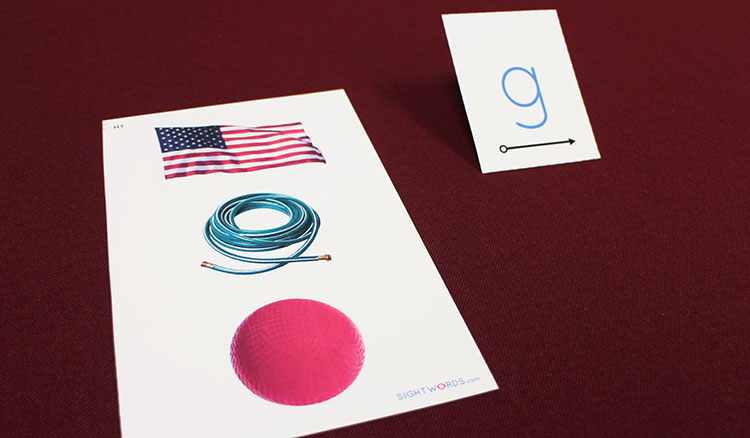H2: Finish the Word
1. Overview
Blend the first part of a spoken word together with the final phoneme (sound), with and without picture cards as visual clues./fla/ • • /g/-/g/-/g/ … finish the word!This game introduces the skill of paying attention to an individual final sound within a word. It also uses letter cards to reinforce the idea that lower-case letters are what certain sounds look like when we write them.

/fla/ • • /g/-/g/-/g/ … finish the word!
2. Materials & Preparation
- Script
- picture cards and word index
- list of ending sounds
- sound cards for the consonants — you will not need c, h, q or y for this activity
3. Activity
Video: How to play Finish the Word
In each session of this game, you will go through the pictures for three different ending sounds. Prop up the three sound cards so that your child is looking straight at them. Lean them against blocks so that they are angled appropriately. Have the child point to each of the sound cards and say the correct sound.
Adult: Remember what sound each of these written sounds makes? Point to each one and tell me its sound. Child: /g/, /rrr/, /k/.
Part A: With Pictures
Take the six picture cards with the first ending sound (for example, /g/) and quickly review the picture names of all 18 pictures on those cards with the child.Adult: [showing picture card] Look at these pictures. They show flag, hose, and ball. Now you name each picture as I point to it. Child: Flag. Hose. Ball. Adult: Good.Now place the first picture card underneath or to the left of the sound cards, which should remain propped up so the child is looking directly at them while doing this activity.
Adult: Now I’m going to put a card with three pictures next to the sound cards. Then I’ll say a word in two parts. I’ll start with the first part of the word and then I’ll say the last sound. You listen, point to the sound card for the last sound, and tell me the word. The word is the same as one of these pictures. Let’s do one. Listen: fla • • g. Fla • • g-g-g. What’s the word? Child: Flag! Adult: Yes! Now point to the /g/ card and say its sound. Child: [pointing to sound card] /g/ Adult: Good job.Be sure to enunciate the target words very clearly, emphasizing the ending sound. Now go through the other five picture cards for that ending sound. Then repeat the process with the picture cards for the two other ending sounds.
Part B: Without Pictures
After going through all the words for those three ending sounds with the picture cards, go through the same words without the picture cards. This makes the activity just a bit harder for the child. Keep all three sound cards in front of your child.NOTE: Do not show the d sound card when going through the d pictures, unless your child is to the point of always recognizing lower-case b correctly. Because the letters b and d look so similar, young children can be easily confused and have lots of trouble telling the two letters apart. So for now we will show only the b sound card and focus on teaching the child to hear the difference between /b/ and /d/.
↑ Top4. Suggested Schedule
You will do this activity with your child several times in order to familiarize the child with hearing all the different consonant ending sounds. Cover three sounds (phonemes) per daily lesson. Example: In the first session with this activity, you will go through the sounds /mmm/, /sss/, and /t/ with pictures, followed by going through /mmm/, /sss/, and /t/ without pictures. NOTE: If you are short on time, a session can be split into two parts — with and without pictures. Example: in the first session, go through the sounds /mmm/, /sss/, and /t/ with pictures. In the second session, go through /mmm/, /sss/, and /t/ without pictures.| Day | Sounds |
|---|---|
| 1 | m, s, t |
| 2 | v, d*, l |
| 3 | f, p, n |
| 4 | g, r, k |
| 5 | b, j, x |
| 6 | w, z |
5. Confidence Builder
If the child struggles, slow down the pace and go through just two letter sounds per session instead of three. ↑ Top6. Extension
Using the same cards from the activity above, show the child the target word on the first card and say:Adult: Do you remember what we called this a picture of? Child: A flag! Adult: Yes, flag. This time I will point to the picture and say its first part. Then I want you to say the last sound in the word, and finish up by saying the whole word. Get ready to say the last sound and finish up my word: flag. Fla… Child: /g/. Flag. Adult: Yes! Now try to finish some more of my words.Point to another card with a picture that ends with /g/ and repeat this process. Have the child touch the corresponding sound card (g) and picture (e.g., dog) after finishing each word. ↑ Top
7. Small Groups (2-5 children)
Lesson Objective: Using pictures and selected consonant letter cards as visual aids, children will hear a word spoken in two parts, identify its ending phoneme, and orally blend the parts into a whole word. GELDS (Georgia Early Learning & Development Standards): CLL6.4a Georgia Standards of Excellence: ELAGSEKRF3.a Common Core State Standards: CCSS.ELA-LITERACY.RF.K.3.A Additional Materials:- optional: three letter sound cards for each child
- three wooden blocks for each child
- extra letter sound cards
Leave a Reply
